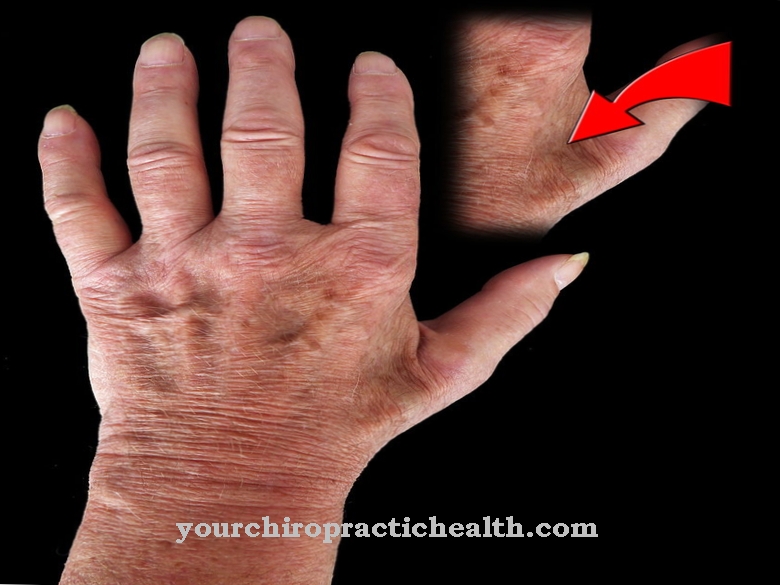Sometimes you notice a benign thickening in the subcutaneous fat tissue. It is a harmless, benign fatty tumor, a Lipoma.
What is a lipoma?

© olando - stock.adobe.com
Lipomas mostly appear as small lumps in the subcutaneous tissue on the arms, thighs or in the abdomen, but they can also be found in the muscles, in the chest, esophagus, in the airways and in the intestines. Lipomas rarely cause discomfort and therefore usually do not need to be removed. Removal and treatment is only mandatory if it is a malignant tumor, a liposarcoma.
Lipomas are thickened nodes in the subcutaneous tissue, the subcutaneous layer. About half of all lipomas settle there. The size can vary from the size of a lentil to 20 centimeters. Under the microscope you can see a benign growth of the fatty tissue that has become encapsulated.
A lipoma sometimes appears between the ages of 20 and 25 and usually only grows very slowly. In principle, however, a lipoma can occur at any age. If lipomas occur frequently, it is called lipomatosis. A lipoma can feel soft or plump.
causes
For the Lipoma no exact causes can be identified. As with other benign tumor formations in, one does not know why and what causes it. Doctors suspect a hereditary predisposition. Changes on chromosome 12 were found in some people.
In addition, there has been speculation that a lipoma could be caused by a violent bump or bruising. Obesity as a cause could not be proven. Lipomas are just as common as slim people as overweight people.
Symptoms, ailments & signs
Lipoma rarely presents with symptoms. It is only visible as a rubbery, usually easy-to-move lump under the skin. Moving it often leads to a strange sensation. Often the lipoma appears to be numb. Otherwise, very few people who have a lipoma complain of any complaints.
In rare cases, pressing a lipoma on is painful. This is especially true for lipomas in which blood has collected. Such a lipoma can lead to pain even without external influences. These pains usually correspond to a feeling of tension or pressure, more rarely an uncomfortable pulling.
At most, lipomas still lead to symptoms in unfavorable places. This applies, for example, when one of the tumors presses against the carotid artery and reduces the blood flow to the brain. In such cases, dizziness and circulatory problems can occur.
A lipoma can also affect tendons or nerves and cause pain when moving. There may also be a tingling sensation due to a struck nerve or pain that is difficult to grasp. If such growths are touched, the symptoms can be exacerbated. They can also get worse if the lump migrates under the skin or becomes larger.
Diagnosis & course
A Lipoma Very rarely causes discomfort and is usually discovered by chance as a small subcutaneous thickening. A benign lipoma can be moved back and forth a little. A lipoma can cause discomfort if it is located near a nerve pathway or on the joint.
Since a small lipoma is difficult to distinguish from its surroundings, a diagnosis is difficult to make. A lipoma and the adjacent fatty tissue are difficult to distinguish from one another. A dermatologist should be consulted for the diagnosis.
In order to pinpoint it, the doctor can puncture the lipoma to distinguish it from other benign growths, e.g. B. cysts that are filled with fluid succeed. The size of a lipoma can be determined by ultrasound. Computed tomography only needs to be done if liposarcoma is suspected.
Complications
As a result of the lipoma, patients usually suffer from thickening that occurs on the affected person's skin. In most cases, these thickenings occur on the abdomen, arms or legs. In most cases there are no particular complaints or pain. Other complications usually do not occur either. However, the aesthetics of the person affected can be restricted by the lipoma, leading to psychological complaints or depression.
Inferiority complexes or a reduced self-esteem can also occur and reduce the patient's quality of life. In some cases, a lipoma can also negatively affect joints, causing pain. In most cases, treatment is carried out by surgery. There are no particular complications or complaints.
In some cases, a scar may remain. The life expectancy of the patient is not affected by a lipoma. The lipoma can also be suctioned off. In most cases, no scars are left behind. There are no further complications or complaints.
When should you go to the doctor?
If unusual skin changes such as growths, redness or lumps under the skin are noticed, a doctor should be consulted as soon as possible. A medical professional must examine the signs and rule out or confirm a lipoma as the cause. Treatment is necessary in any case, because if left untreated, the tumor can spread and spread to the surrounding body regions. There is also the risk of malignant metastases. People who have already suffered from lipoma belong to the risk groups and should consult their family doctor if the symptoms are described.
The same applies to people who have a genetic predisposition, take medication regularly or who have an increased risk of developing cancer due to an unhealthy lifestyle. Parents who notice lipoma symptoms in their child should immediately consult the responsible pediatrician and have the signs clarified. In addition to the general practitioner, a dermatologist or internist can be called in. If the growths are located in the area of the intestine, a gastroenterologist should also be called in.
Treatment & Therapy
In most cases a Lipoma not treated because it does not cause discomfort. However, if it is very large, attached to a nerve tract or a joint and causes discomfort, it can be surgically removed. In most cases, a local anesthetic is sufficient; general anesthesia is only required for larger lipomas.
The surgeon removes the lipoma with its capsular tissue and sutures the wound. Usually a small scar remains. In rare cases, complications such as injuries to the adjacent skin tissue or bleeding, infections and wound healing disorders can occur as with other surgical interventions. Sometimes removal does not help either, because the lipoma can recur in the same place as a recurrence and must be operated on a second time.
A newer method is suctioning off the lipoma. This has the advantage that smaller scars remain, but the disadvantage that not all fat cells may also be removed. A smaller lipoma can also be removed using lipolysis ("fat-away syringe").
Naturopathy sees lipomas as a build-up of metabolic waste materials that - instead of being transported away - build up in the tissue. Accordingly, it starts with the lymphatic system and tries to stimulate it to excrete the waste products using suitable healing methods.
Outlook & forecast
The prognosis for lipomas is very good. The capsules can be treated surgically or with medication and usually do not cause any further complications. If the lipomas are removed too late, permanent damage may already have occurred. For example, lipomas can press on organs and the surrounding tissue and cause functional impairments. Lipomas can form again and again. In individual cases, the benign soft tissue tumor can develop into a chronic disease. For the patient, this means regular doctor visits and exhaustive treatments.
Very rarely, a lipoma can degenerate into a malignant liposarcoma. In general, however, the prognosis is positive. Subcutaneous lipomas can be permanently removed. They pose a cosmetic problem, but are not seriously harmful to health. Typical complications can occur during treatment. The surgical scar can become inflamed or open. Any complications slow recovery and can lead to permanent skin damage.
The prognosis also depends on the location of the lipomas. If the tumors are in the genital area or on the head, treatment is associated with risks. The doctors explain the prospects to the patient before the procedure.
prevention
The exact causes of the formation of Lipomas are not known. Therefore, it is also difficult to take preventive measures.
Aftercare
A lipoma causes thickening of the skin, which in itself is not a health threat. Only the aesthetics suffer from the lipoma and are difficult to endure for those affected, which is why aftercare focuses on finding a good way to deal with the disease.
Sometimes this promotes the development of depression and psychological complaints, which should be clarified with a psychologist. Therapy can help promote a self-confident approach to the disease and increase wellbeing. Sufferers should try to focus on a positive healing process despite the adversity. To build the appropriate posture, relaxation exercises and meditation can help calm and focus the mind.
== You can do that yourself ==
In addition to the medical removal of a lipoma through an operation or cosmetic procedure by means of liposuction, natural home remedies and natural medicine for personal use can of course also help to treat a lipoma quickly.
The most important thing for those affected is the change in diet. For example, avoiding artificial flavorings, consuming solid foods and removing processed foods from the diet can help. In addition, an excess of alkaline diet, a lot of sport and exercise, the intake of mineral earth and the use of a deacidification treatment or a detoxification treatment are recommended. Mineral earth in particular has an increased binding capacity, which has a very positive effect on the rapid elimination of excess acids and metabolic waste products.
In addition, some herbs, such as turmeric and sage, can be very helpful in breaking down lipoma. Honey and beeswax can be particularly helpful in combating lipomas. Saturated fatty acids, refined oils, additional preservatives, pesticides, and white flour and milk should be avoided as far as possible. We recommend a morning cup of lukewarm water with fresh lemon juice as well as the intake and increase of omega-3 fatty acids and fresh plant shoots.




.jpg)







.jpg)



.jpg)










.jpg)
